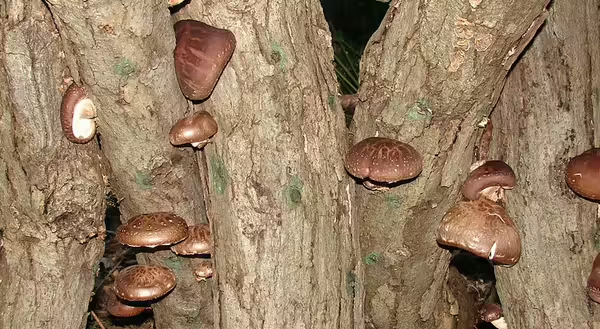
Growing mushrooms is a time-honored tradition.
Cultivation of shiitake mushrooms on hardwood logs dates back at least 1000 years in Japan. After button mushrooms, the shiitake mushroom is the most commonly cultivated mushroom in the world, according to Cornell University. Despite their high retail cost, growing shiitake mushrooms is achievable at home without great expense.
Shiitake mushrooms (Lentinula edodes) are an edible fungus, native to East Asia. They have a large, umbrella-like shape; are dark brown and white in color; and are well-known for their rich, meaty, umami flavor and health benefits.
The shiitake fungus is saprophytic – meaning it penetrates, dissolves, and absorbs its nutrients from dead organic matter, like a fallen tree. When windborne spores of shiitake encounter exposed dead wood, a spore can germinate, just like a seed, and eventually forms mycelium. Mycelium is the vegetative portion of the fungus, and it forms a microscopic hair or root-like structure which is used to excrete enzymes (digestive juices) into wood to make it food. Once most of the food source is consumed, the fungus produces “fruit” aka mushrooms. The mushrooms produce spores that become windborne to continue the life cycle of the fungus. The only difference between growth of the shiitake fungus in the wild and cultivated shiitake is the intentional inoculation of high-quality wood using appropriate tools.
For Central Illinois residents interested in growing shiitake mushrooms on logs, they should source maple or oak logs, which grow in groves in specific regions of the state. Oaks and maples are the most reliable wood source for a beginner grower to grow shiitake mushrooms, especially sugar maple or white oak.
Hardwood logs prepared for mushroom cultivation (inoculation) are called “bolts”.
They should be freshly cut in the previous three months, from healthy trees. Bolts four to eight inches in diameter and three feet in length are highly desirable -- larger logs can be extremely heavy due to water and sap retained in the wood.
To source bolts, locate maple or oak groves in your area and contact the property owner about their timber management practices. If the owner utilizes TSI (Timber Standard Improvement), you may have a source of fresh-cut logs. According to IDNR, TSI is the practice of removing undesirable trees to increase resources (space, light, water, and nutrients) for desirable trees.
Inoculation requires...
- Power drill
- 5/16” brad point drill bit & stop collar
- Food-grade wax
- Old sauce pot and camp stove
- Small paint brush or sponge dauber
- Hammer
- Shiitake mushroom “plug spawn”
Resource online mushroom supply companies for plug spawn, food-grade wax, and drill bits.
Steps to Inoculate a Bolt:
- Drill holes in a line on the bolt, 4-6" apart. Alternate starting distance from log end to create a diamond pattern of holes.
- Hammer plug spawn into holes, flush with bark.
- Cover holes with melted wax to inhibit entry of competitor fungus.
The Spawn Run
Store inoculated bolts on a raised surface (like a pallet) in a moist, shady area for six - twelve months. Use straw or leaf cover to retain moisture. During this rest period, known as the “spawn run”, mycelium will take over the log. According to the University of Vermont Extension, time to “fruiting” depends on temperature, moisture levels, and mushroom variety, but typically it takes eight to twelve months.
Harvest
To harvest the fruit (mushroom), gently twist and pull them from the log. Harvest young, firm mushrooms – old mushrooms are tough and bitter. If allowed to fruit naturally outdoors, with the changing weather and seasons, a bolt will continue fruiting for years to come.
Learn More
To learn more about mushroom log inoculation, contact Nick Frillman, University of Illinois Extension Local Foods Systems & Small Farms educator, at frillma2@illinois.edu or 309-663-8306.
Photo Credit: "Shiitake Growing On Logs In Our Garden" by dominik18s is licensed under CC BY 2.0.
ABOUT THE AUTHOR: Nick Frillman is a Local Foods and Small Farms Educator serving Livingston, McLean, and Woodford Counties. A fourth-generation graduate from University of Illinois, Frillman has a B.A. with a double major of Political Science and Spanish and a M.S. in Crop Science with a focus on crop production. Before joining Illinois Extension, Frillman completed a field season of CSA and farmers’ market-style production at a small “beyond-organic” vegetable farm in Sandy, Oregon.
ABOUT THE EDITOR: Liz Repplinger is the Agriculture and Natural Resources Program Coordinator serving Livingston, McLean, and Woodford Counties. A Bloomington-Normal native, Liz earned a B. A. in Animal Science and an M.S. in Animal Science from Illinois State University. She has enjoyed contributing to the multiple facets of Extension including previous support of the 4-H Youth Development Program as a program coordinator and current support of Unit and Statewide Diversity, Equity and Inclusion Initiatives.